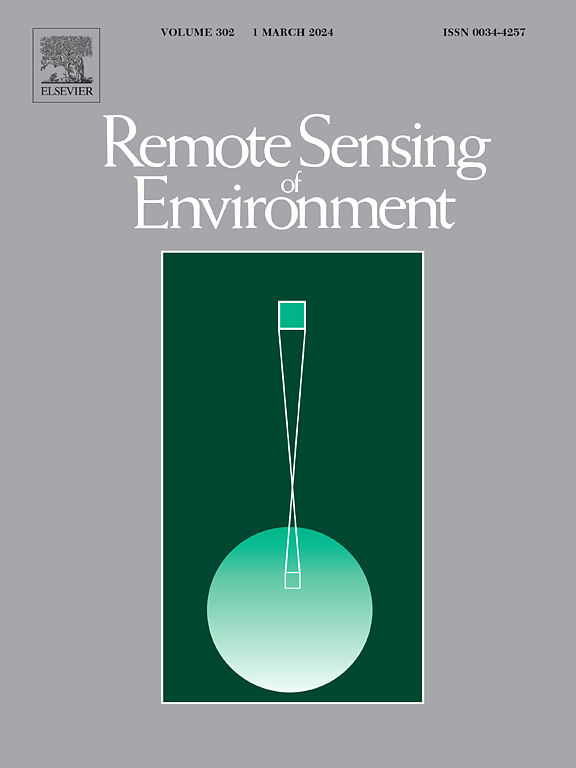On the hotspot-Sun angular offset in urban thermal anisotropy
IF 11.1
1区 地球科学
Q1 ENVIRONMENTAL SCIENCES
引用次数: 0
Abstract
The hotspot-sun angular offset (the spherical circular angle between hotspot and sun positions, termed ΔCA) in urban thermal anisotropy (UTA) plays a pivotal role in advancing remote sensing of urban climates. However, its diurnal and monthly variations across scenarios influenced by sun position, urban morphology, and thermal inertia remain largely unknown. Here we filled this knowledge gap based on 1049 UTA scenarios incorporating 12 urban surface models using both computer simulations and in-situ measurements. Our findings reveal ΔCA varies from 0° to 50° (predominantly 10° – 30°). Surface thermal inertia, urban morphology (i.e., building-street aspect ratio), and sun position collectively drive ΔCA variation, with their relative contributions exhibiting significant diurnal and monthly variabilities. In general, ΔCA is most pronounced around noon with relatively low thermal inertia (279–739 W·s1/2·m−1·K−1) and low aspect ratio values (< 1.5), leading to high ΔCA values exceeding 30°. Monthly ΔCA variations shows a bimodal pattern, with peaks (ΔCA is ∼25°) in April and August and a trough (ΔCA is ∼15°) from May to July around the summer solstice when the solar zenith angle (SZA) is relatively small. Hourly ΔCA variations exhibits sinusoidal variation during daytime, also characterized by a noon trough around the summer solstice. Troughs in diurnal/annual cycles are associated with small SZA (< 20°) and high sunlit roof/ground temperatures that ensure hotspot-sun adjacency. Our results indicate pronounced ΔCAs under scenarios with lower thermal inertia, lower aspect ratio, and midday periods in May to August. Our findings could facilitate designing kernel-driven models for simulating UTA.
城市热各向异性中的热点-太阳角偏移
城市热各向异性(UTA)中的热点-太阳角差(热点与太阳位置之间的球面圆角,简称ΔCA)在推进城市气候遥感中起着至关重要的作用。然而,受太阳位置、城市形态和热惯性影响的日变化和月变化在很大程度上仍然未知。在这里,我们利用计算机模拟和现场测量,基于1049个UTA场景,包括12个城市地表模型,填补了这一知识空白。我们的研究结果显示ΔCA从0°到50°变化(主要是10°- 30°)。地表热惯性、城市形态(即建筑-街道纵横比)和太阳位置共同驱动ΔCA变化,它们的相对贡献表现出显著的日和月变化。一般来说,ΔCA在中午前后最为明显,热惯性相对较低(279-739 W·s1/2·m−1·K−1),纵横比较低(<;1.5),导致ΔCA值高,超过30°。每月ΔCA变化呈双峰型,峰值(ΔCA为~ 25°)出现在4月和8月,低谷(ΔCA为~ 15°)出现在5月至7月夏至前后,此时太阳天顶角(SZA)相对较小。每小时ΔCA的变化在白天呈正弦变化,夏至前后也有一个正午槽。日/年周期中的波谷与小SZA (<;20°)和高阳光照射的屋顶/地面温度,确保热点与太阳相邻。我们的研究结果表明,在5月至8月较低的热惯性、较低的纵横比和正午时段,ΔCAs是显著的。我们的发现有助于设计内核驱动模型来模拟UTA。
本文章由计算机程序翻译,如有差异,请以英文原文为准。
求助全文
约1分钟内获得全文
求助全文
来源期刊

Remote Sensing of Environment
环境科学-成像科学与照相技术
CiteScore
25.10
自引率
8.90%
发文量
455
审稿时长
53 days
期刊介绍:
Remote Sensing of Environment (RSE) serves the Earth observation community by disseminating results on the theory, science, applications, and technology that contribute to advancing the field of remote sensing. With a thoroughly interdisciplinary approach, RSE encompasses terrestrial, oceanic, and atmospheric sensing.
The journal emphasizes biophysical and quantitative approaches to remote sensing at local to global scales, covering a diverse range of applications and techniques.
RSE serves as a vital platform for the exchange of knowledge and advancements in the dynamic field of remote sensing.
 求助内容:
求助内容: 应助结果提醒方式:
应助结果提醒方式:


